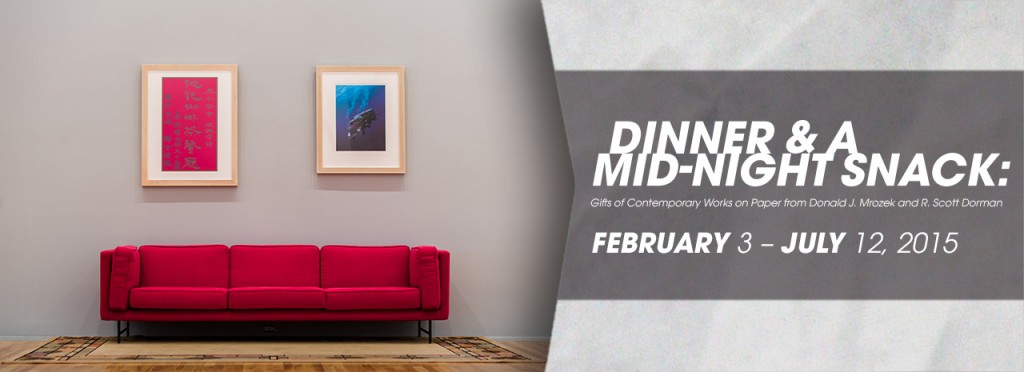This essay is a reflection by Katie Kingery-Page upon the current exhibit in the Pelton and Hyle galleries, Dinner and a Midnight Snack: Gifts of Contemporary Art from Donald J. Mrozek and R. Scott Dorman. Kingery-Page is guest co-curator of the show and associate professor of landscape architecture at K-State.
Donald Mrozek and Scott Dorman’s collection of contemporary works on paper bridges between quiet, minimalist moments and more frenetic, post-modern moments in late twentieth century art. The works in Dinner and a Mid-night Snack can be seen as a collection of dialectical moments:
quiet : agitated
austere : hilarious
fragmented : whole
minimalist : postmodern
I am interested in minimalism; my interest comes from working as a landscape architect in the beautifully austere landscape of the Kansas Flint Hills. This landscape possesses what landscape theorist and practitioner Catherine Dee calls an “aesthetic of thrift.”1 I am also interested in the rich multiplicity of postmodern art; I owe this interest to an art education in the 1990s, a time when performance, video and film were as much part of the sculpture idiom as objects themselves.
Describing a minimalist aesthetic, Ad Reinhart wrote, “Everything is on the move. Art should be still.”2 Donald Judd, although popularly understood as a minimalist artist, rejected the term and wrote to clarify his intent, making clear that he was concerned with specific, rather than general, meanings. His work communicated about material, time and place, with visual austerity: “have [the] whole without the parts” Judd wrote in a note for his essay “Specific Objects.”3
The title piece for this show is a print by Chryssa Mavromichali (who preferred to be known as Chryssa), containing bits and parts of Chinese text seemingly drawn from a restaurant window or flier, advertising various foods as “dinner and a mid-night snack.”4 Chryssa’s work, both sculpture and works on paper, includes text in many forms, richly combined as neon light and color compositions. In a 1966 interview, Chryssa said, “I have always felt that when things are spelled out they mean less, and when fragmented they mean more.”5
The Chinese text in Chryssa’s Calligraphy III seems subtly humorous, as the formal calligraphy gives an air of importance and yet the words’ meaning is that of a restaurant menu. The reference to everyday activities in Calligraphy III seems evocative of the collection as a whole. Mrozek and Dorman enjoyed these works in the context of their home, and spoke with us about the experience of living with contemporary art in the kitchen, around the dining table, and throughout the house.
In the course of working with Thomas Bell to curate the show, I returned several times to critical reflections about postmodern sculpture. Many of the prints in Dinner and Mid-night Snack are by artists most known for their sculpture, such as Robert Morris. Lucy Lippard saw “…connection and separation, or wholeness through fragmentation,” in Robert Morris’ early 1960s work.6 Rosalind Krauss wrote about the fragmented nature of postmodern sculpture in her 1977 book, Passages in Modern Sculpture, referring not just to physical fragmentation, but also to the fragmentation of imagery and concepts.7
Wholeness through fragmentation is a postmodern idea akin to the complexity of landscapes. Imagine the contemporary urban landscape of a city in the Midwestern United States; you will likely picture an accumulation of built (and re-built) city blocks interrupted by green spaces and un-designed “wildscape”8 remnants of vacant lots reverting to nature. Like art, landscapes contain many implicit, specific meanings (fragmentation) and also function as a whole when viewed through different lenses. For art, the lens of wholeness may be considering disparate works in context of a common cultural era or location. In landscape, diverse layers of meaning can be viewed as a whole through the lenses of ecology, politics, or cultural history.
Considering the works in Mrozek and Dorman’s collection, Thomas Bell and I saw a potential for the postmodern works to serve as a sort of visual access point for visitors into minimalist works, which are often misunderstood. Ultimately, the experience of art is a personal one. The groupings evolved as such. Posing places to sit, to be with art (whether looking or not) was essential to the exhibit design. We invite you to come in, sit down, and stay awhile. Feel free to take off your shoes.
[1] Catherine Dee. 2010. “Form, Utility, and the Aesthetics of Thrift in Design Education” Landscape Journal 29:21-35; doi:10.3368/lj.29.1.21
[2] Ad Reinhardt “Twelve Rules for a New Academy” in Gregory Battcock (ed.) 1966 The New Art: a Critical Anthology. New York: EP Dutton & Co., Inc: 201.
[3] cited in Richard Shiff “Specificity” in Marianne Stockebrand (ed.) 2009 The Writings of Donald Judd. Marfa TX: Chinati Foundation: 92
[4] Translation courtesy of Dr. Daniel Fung and Dr. Catherine Fung.
[5] 1966 quote from New York Herald Tribune cited in New York Times “Chryssa, Artist Who Saw Neon’s Potential as a Medium, Dies at 79” Margalit Fox January 18, 2014.
[6] From Lucy Lippard “New York Letter 1965” in Gregory Battcock (ed.) 1966 The New Art: a Critical Anthology. New York: EP Dutton & Co., Inc: 196.
[7] Rosalind Krauss. 1981. Passages in Modern Sculpture. Cambridge, MA: MIT Press. First published in 1977.
[8] Anna Jorgenson and Richard Keenan (eds.). 2012. Urban Wildscapes. London: Routledge.
